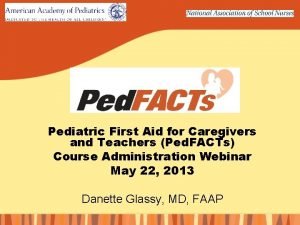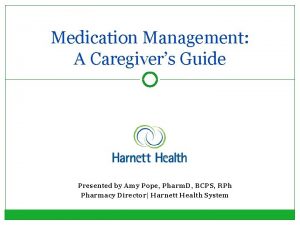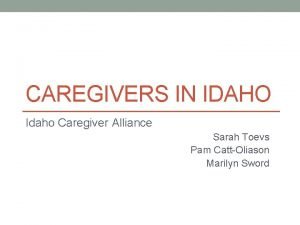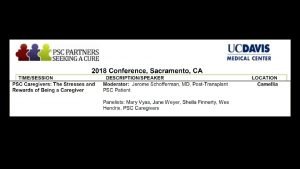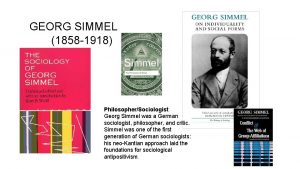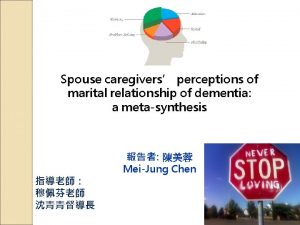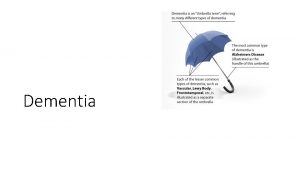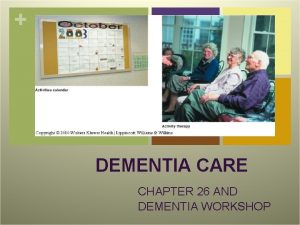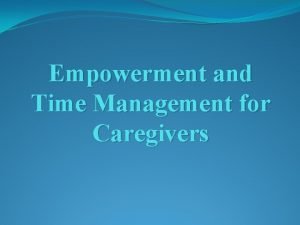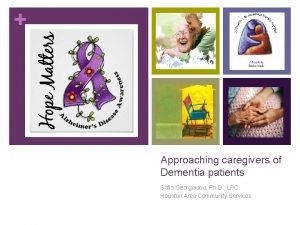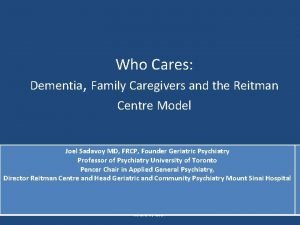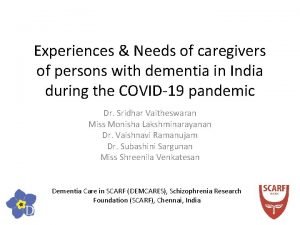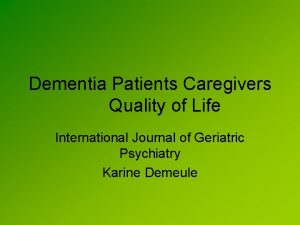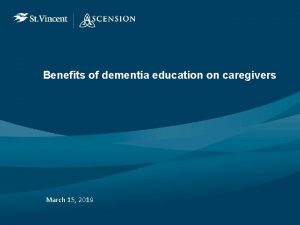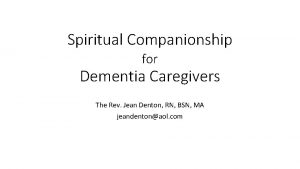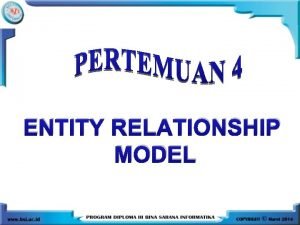Spouse caregivers perceptions of marital relationship of dementia




























- Slides: 28

Spouse caregivers’ perceptions of marital relationship of dementia: a meta-synthesis 指導老師: 穆佩芬老師 沈青青督導長 報告者: 陳美蓉 Mei-Jung Chen 1

Overview Background Ø Objectives Ø Inclusive criteria Ø Exclusive criteria Ø Search strategy Ø Data collection ØData synthesis Ø 2

Background Ø Estimate 5. 4 million Americans to have Alzheimer’s disease and continue to grow rapidly in the future (Alzheimer’s Association, 2012). 3


Background Caregiving üMore than 15 million Americans provide unpaid care for a person with dementia (Alzheimer’s Association, 2012). ü 80% of care provided at home is delivered by family caregivers. üMost family caregivers are women; spouses and daughters; “informal” (unpaid) 5

Background Caregiving Career p Dementia caregiving, 60 hours per week at home; 5 -10 year “career”. p 61% family caregivers of dementia experience high level of emotional stress and depression (Hanninen et al. , 2002). p 72% of family caregivers experienced relief when the person died. 6

Background Equity Theory and Intimate Relationships u costs versus reward u couples feel most comfortable when their relationships are maximally profitable and they are getting exactly what they deserve from their relationships. u theorists point out men and women who are unfairly treated for a prolonged period will begin to wonder. Does my partner love me? Why would he (she) treat me so unfairly? Am I getting all I deserve in this relationship? Hatfield, E. (2009) 7

Characteristics of Intimate Relationships (1) Intimate Relationships: Relationships between loving persons whose lives are deeply intertwined. Intensity of Liking (Loving). Intimate relationships are carried on by people who like or love one another. 8

Characteristics of Intimate Relationships(2) Depth and Breadth of Information Exchange Intimates generally share profound information about one another's personal histories, values, strengths and weaknesses, hopes, and fears. Intimacy is referred to as feelings of closeness, Warmth, connectedness, bondedness in loving relationships (Sternberg, 1997). 9

Background 1. Phenomenological approach 2. 10 participants 10

Background p the degree of intimacy perceived by caregivers to both sexual and emotional factors within the dementia affected relationship (Harris et al. , 2011). p The impact on their spousal relationship could be increased or decreased (Harris et al. , 2011). 11

n 80% of couples indicated that the disease of dementia affects the sexuality (Harris et al. , 2011). n Simonelli et al. (2007): more experience of no sexual intercourse was reported by participants. 12

Background older husbands care for wives with dementia found that husbands experienced changes in the ways that they adapt their marital roles (Sanders & Power, 2009). 13

Davies et al. (2010) Ø Focus Group Ø understand communication marital cohesion, affection expression, burden, ambiguity. Ø Findings: 1. more difficulties with communication, marital cohesion and perceptions of increased burden. 2. reduced sexual expression due to physical limitations 3. substitute activities including handholding , massaging and hugging 14

Background Adams, Wampler, and Kaszniak (2001) stated many spousal caregivers changed the way that they viewed their spouse and their marital relationship as dementia progressed. Some spouse caregivers have experienced the role shift, from a sense of “we” or “us” to more separation and independence。 15

From "You" and "Me" to "We. 16

Objectives Ø Examined the experiences of spouse caregivers’ perceptions of marital relationship of dementia. 17

Inclusive criteria Type of participants p. Husband caregivers of dementia p. Wives caregivers of dementia 18

Inclusive criteria Types of Phenomena of interest p The qualitative component of the review will consider the spouse caregivers’ experience on the impacts of marital relationship, intimacy and role during the progress of dementia. p The key phenomena to be investigated will be: dementia experiences, marriage relationship, intimacy, sexual and role. 19

Inclusive criteria Types of studies p The qualitative component of the review will consider studies that focus on qualitative data including, but not limited to, designs such as phenomenology, grounded theory and ethnography. p Only studies published or available in English or Chinese, in peer reviewed journals and undertaken between 1990 and December 2012 were included. 20

Exclusive criteria u. Spouse caregivers of other disease u. Children caregivers of dementia u. Grandchildren caregivers of dementia 21

Search strategy Databases English or Chinese published articles between 1990 and 2012 will be collected. u CINHAL(Fulltext) u Pub. Med u Medline u Pro. Quest Nursing & Allied Health Source u CEPS(華藝線上圖書館) u 台灣博碩士論文知識加值系統 u Google Scholar 22

Assessment of Methodological Quality p Qualitative papers selected will be assessed by two independent reviewers for methodological validity prior to inclusion in the review using JBI-QARI. p Disagreements that came up between the reviewers were resolved through discussions p Opinion and Text Assessment and Review Instrument (JBI-NOTARI). 23

Data collection u Qualitative data will be extracted from papers included in the review using the standardised data extraction tool from JBIQARI. u The qualitative and textual data extracted will include specific details about the populations, study methods and outcomes of significance to the review question and specific objectives. 24

Data synthesis u. Qualitative research findings will, where possible, be pooled using JBI-QARI. 25

Data synthesis u. The pooling process involved the findings with sets of representative statements in the form of illustrations endorsing the findings (Level 1 findings) u these findings were rated according to their quality (according to the JBI-QARI degrees of credibility scale) later placed in categories on the basis of similarity in meaning (Level 2 findings). u. The level 2 findings were then subjected to a metasynthesis to produce a single comprehensive set of synthesized findings (Level 3 findings). 26

References Baikie, E. (2002). The impact of dementia on marital relationships. Sexual and Relationship Therapy, 17(3), 289299. Braun M. , Scholz U. , Bailey B. , Perren S. , Hornung R. , & Martin. Delicious M. (2009). Dementia caregiving in spousal relationships: a dyadic perspective. Aging Mental Health, 12(3), 426 -436. Hatfield, E. (2009). Equity theory. In Harry Reis & Susan Sprecher (Eds. ) Encyclopedia of human relationships. (pp. 535 -537). Thousand Oaks, CA: SAGE. Harris, S. M. , Adams, M. S. , Zubatsky, M. , & White, M. (2011). A caregiver perspective of how Alzheimer’s disease and related disorders affect couple intimacy. Aging & Mental Health, 15(8), 950 -960. Walster, E. , Walster, G. W. & Berscheid, E. (1978) Equity Theory and Intimate Relationships. 27

28
 Marital stability is synonymous with marital happiness.
Marital stability is synonymous with marital happiness. Caregivers
Caregivers Pediatric first aid for caregivers and teachers
Pediatric first aid for caregivers and teachers Caregivers guide to medication
Caregivers guide to medication Professional boundaries for caregivers
Professional boundaries for caregivers Idaho family caregiver conference
Idaho family caregiver conference Boundaries for caregivers
Boundaries for caregivers A chemical substance that alters perceptions and moods
A chemical substance that alters perceptions and moods Trust your perceptions
Trust your perceptions Drugs that alter moods thoughts and sense perceptions
Drugs that alter moods thoughts and sense perceptions Psychedelic drugs that distort perceptions and evoke
Psychedelic drugs that distort perceptions and evoke Drug that alters moods, thoughts, and sense perceptions
Drug that alters moods, thoughts, and sense perceptions Charles babbage spouse
Charles babbage spouse Aziz sancar
Aziz sancar Henri fayol spouse
Henri fayol spouse Spouse education and career opportunities
Spouse education and career opportunities Jerome bruner spouse
Jerome bruner spouse God spouse child
God spouse child Cleopatra spouse
Cleopatra spouse Cosign spouse idr
Cosign spouse idr Anna dymna spouse
Anna dymna spouse Manuscripts don t burn bulgakov
Manuscripts don t burn bulgakov Richard bach spouse
Richard bach spouse Amelia earhart spouse
Amelia earhart spouse Defence of a filipina woman's honour
Defence of a filipina woman's honour Dyad triad quadrad
Dyad triad quadrad God husband wife
God husband wife Pablo neruda spouse
Pablo neruda spouse Never talk bad about your spouse quote
Never talk bad about your spouse quote


